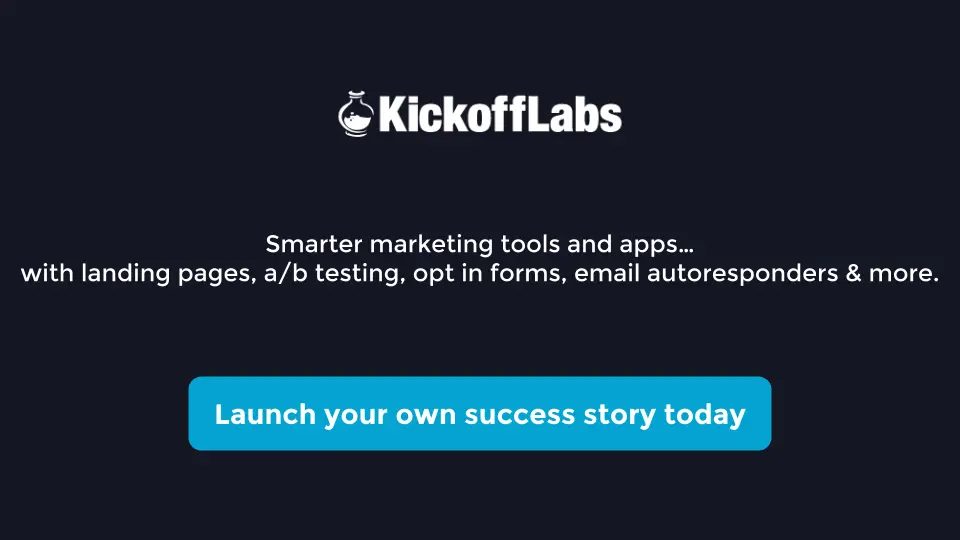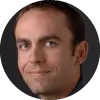
Josh Ledgard, Co-Founder of KickoffLabs:
Rossa Shanks and his co-founder, Rich Brown, in the last few years have secured 300,000 Facebook fans; 45,000 Twitter followers; they crowdfunded their business… and most recently collected an additional 50,000 email subscribers on their most recent campaign for the Great Little Place app through KickoffLabs.
What’s your background? What got you to the start of Great Little Place?
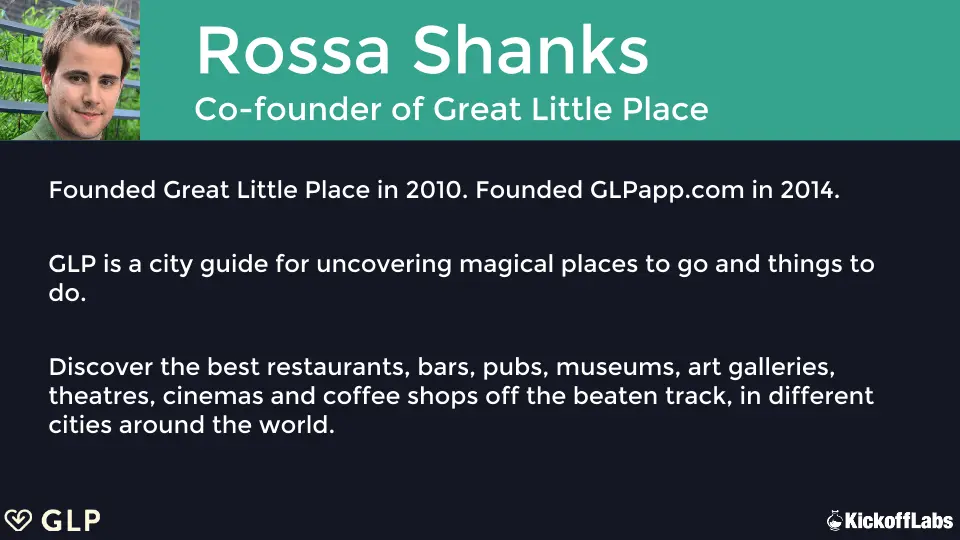

Rossa Shanks, Co-Founder of Great Little Place:
I started my career in advertising where I worked at a couple of different ad agencies. The first was AMV BBDO, then at Grey London.
I cut my teeth in advertising, which is a great grounding for building a business. You learn how to build a brand, what’s an incredible value proposition, how to reach an audience and engage an audience. From a marketing point of view, it was kind of perfect.
That’s where I met my co-founder, Rich Brown, as well. We weren’t at the same ad agency, but we met at a course, and then started talking about this idea.
We basically started the idea in our spare time. It was kind of a passion project where we really enjoyed finding kind of quirky, off the beaten track places.
Before we went full time in it, I ended up head of marketing at the Sun newspaper, which is one of the biggest newspapers here in the UK. Rich (my co-founder) left advertising as well and moved down more of a kind of product management route, and got into user experience.
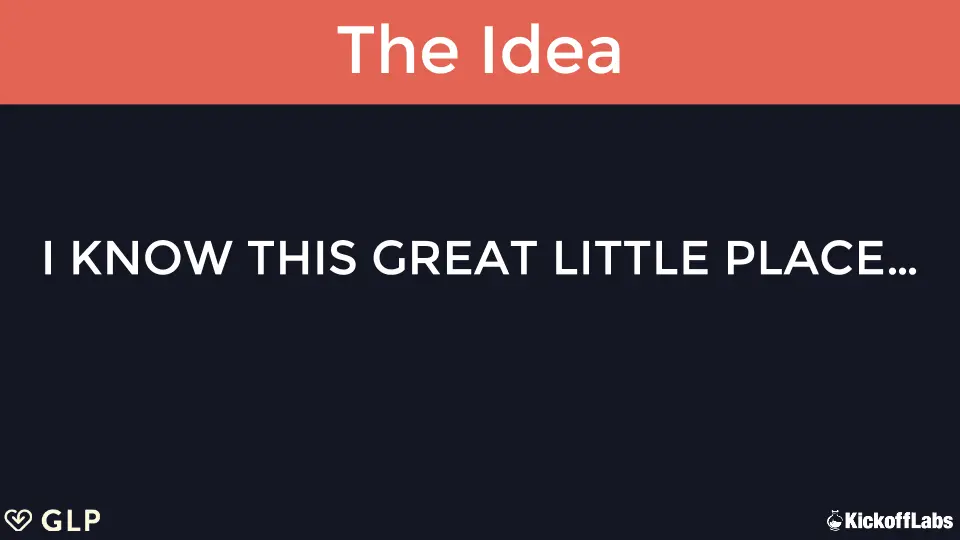

Josh Ledgard, Co-Founder of KickoffLabs:
It’s clear that you guys are trying to do something different than Yelp, Foursquare, Time Out, or one of the more traditional travel sites.
What makes your idea different than what other companies are doing?

Rossa Shanks, Co-Founder of Great Little Place:
I think it’s a few things. The first comes from what the value proposition is.
Our idea was really simple: Everyone loves great little places… the kind of places you tell a story about, places with personality.
The trick is they’re really hard to find and it’s amazing when you stumble across one, but they’re few and far between. There’s obviously a lot of information out there, in terms of finding them, but it’s a bit of a deluge.
We had a idea which is really simple: Everyone knows at least one great little place. If we can get everyone in the world to say, “I know this great little place in …”, and share their amazing discoveries with everyone else, then we might just create the ultimate list.
I think that’s where the differentiation starts. We never sought out to have an app which was just another city guide with places everywhere and anywhere, and you differentiate those places by star ratings.
Ours is much more of a binary platform, whereby… it’s either somewhere great, or it’s not good enough. If it’s not good enough, it’s not on the platform.
When you take that model, you don’t need ratings. To some extent, ratings actually take away from trust versus actually adding trust.
That’s the first thing. Only great little places.
Second is, it’s all personally recommended. We don’t just add business on there randomly. They all come from a recommendation that’s written by a user.
The best bit is that the platform is then self curating, because we don’t get involved editorially; the community decides what stays and what goes. It’s really meritocratic and also democratic.
We might have someone who uses the app in London… or maybe someone from New York travelling in Mexico… and they find somewhere in a random little village and add it. It’s very much like everyone’s little black book of places, woven together.
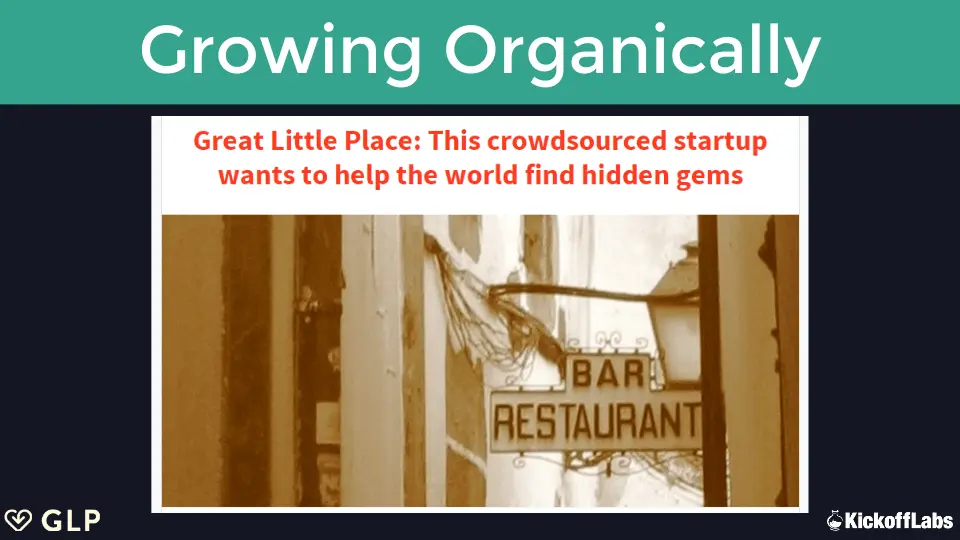

Josh Ledgard, Co-Founder of KickoffLabs:
I think what’s impressive is that they’re really strong about the curation process.
They say it’s self curated, but you can’t just go and submit your local Applebee’s. The rest of the crowd is going to vote Applebee’s right off the list of venues.
Talk about the initial organic grow. You guys started in 2010…
What was the first version of your idea?

Rossa Shanks, Co-Founder of Great Little Place:
A lot of people in the entrepreneurial world know about MVP’s now – minimal viable products.
For us, that wasn’t something that was widespread and certainly not talked about back in 2010. But we instinctively thought to ourselves, “We’re restricted because we don’t have loads of money, we’re not developers… but we want to get this idea out there, test it, and see if it resonates with people“.
We had two things we needed to prove in order to take the idea forward:
- Does anyone care about this idea other than us, and how many people do?
- Would people share their favorite places, or keep them a secret?
We decided that the perfect platform to test the idea was Facebook – an inherently social platform – where people can join in on a page and give recommendations. We set up a page called I Know This Great Little Place in London.
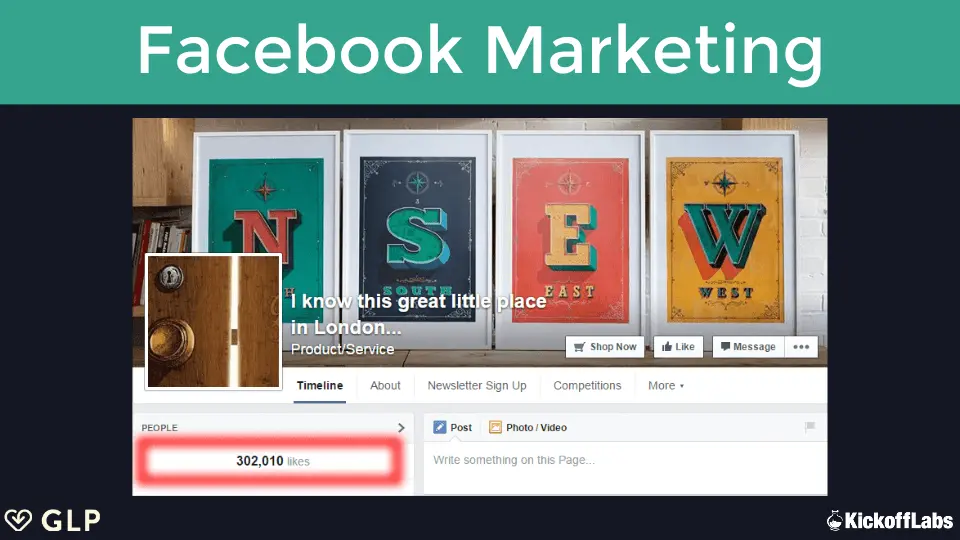
The name of it was intentional; we thought if you saw that name in your news feed and you saw a few of your friends had liked it, there’d be a bit of social proof. But also that name is kind of curious and piques your interest. We thought people would click it and clickthrough.
Luckily our hypothesis was right.
On the first day, we badgered everyone we knew to sign up, because we knew that to trigger a viral effect you need to get as many people together to do something in a short period of time.
Within two weeks it had grown to 40,000 likes!

Josh Ledgard, Co-Founder of KickoffLabs:
How did you get the first 1,000 fans?
Did you have any relationships with key influencers in the market? You have friends in advertising; were they pivotal in getting the first 1,000 to 40,000 fans?

Rossa Shanks, Co-Founder of Great Little Place:
Absolutely. If you think about what might trigger a viral effect, the key thing always is the first group of people knowing each other or being self-referencing, if you like to use a term from the book “Crossing the Chasm”.
If people can’t talk to each other, or don’t know each other… it’s a lot harder for that idea to spread.
If you are within a close community, whether that’s on a university campus or that’s in a certain industry like advertising, that’s critical.
We invited literally all our friends. A lot of them were obviously in advertising, so there’s a lot of overlapping friendship groups, which meant that even though there were only, let’s say, 300 in the first day, it got to 1,000 the second day actually, in London, anyway.
It’s a small community; everyone knows each other. If you were on Facebook, you’d suddenly see 20 of your friends from advertising have liked this page. That was enough of a group of people to start the fire; it’s like the kindling before the fire happened.

Josh Ledgard, Co-Founder of KickoffLabs:
What did you do after the initial traction?

Rossa Shanks, Co-Founder of Great Little Place:
We obviously maintained the communities and gave them a relevant concept that they loved. We’re doing something that people enjoy, so it worked well within Facebook where people are talking about their social lives.
We tested that the idea resonated, then we decided to ask our audience for free money basically.
We wanted to build a website, but couldn’t afford to do it at the time. We also couldn’t develop it ourselves.
So we used Crowdfunder.co.uk to raise over £10,000 pounds from our audience.
That allowed us to build greatlittleplace.com… which was, again, just another way of us proving that the idea worked.
The main hypothesis to prove there was: will people add places on our own platform, not just on Facebook? And they did, in the thousands. That again was a big tic box for us.
But in the back of our minds, we always knew that we wanted to go into mobile. That was going to be the way forward.

Josh Ledgard, Co-Founder of KickoffLabs:
This is an example of one of their posts they did once they started having a following…
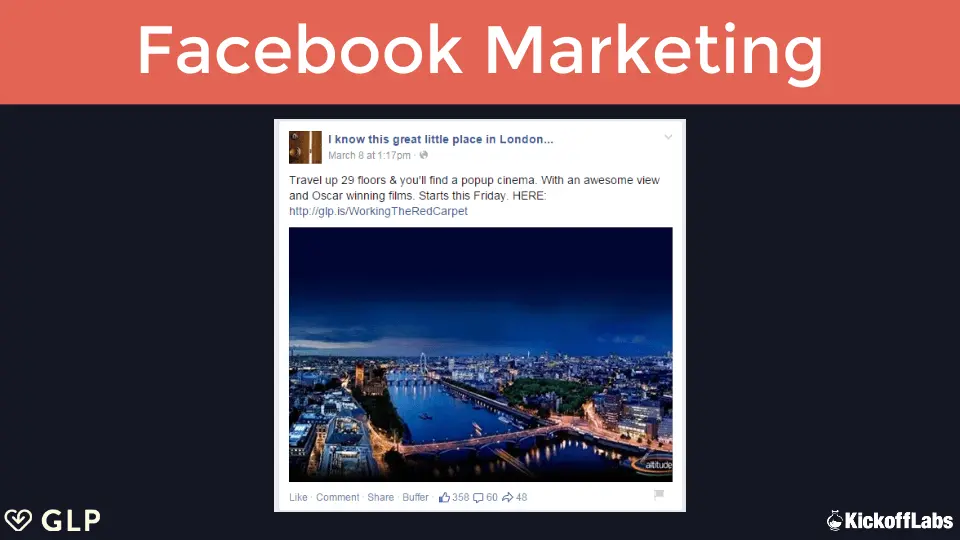
One of the things that work really well for them is the intentional title: “I Know This Great Little Place in London”. I’m sure that got people to read the rest of the posts they were doing, because the title is very thought out in terms of piquing people’s curiosity.
The other thing about it that we see with our customers that works really well is that they’re being very specific in the early days.
It says, “I Know This Great Little Place”… it’s not just any place, it’s a great little place. But they’re also specific about saying London.
They’re very much targeting, while London is a large community, they weren’t saying worldwide we’re going to help you find the best little places.
That contributed a lot to their growth, because we see that technique work well for other companies.
Even if your ultimate plan is to grow beyond just one city, start small, be very focused, and nail it within that community.
It’s very powerful for people because it engages and makes them say, “This is for me because I live there and I like great little places“, as opposed to just saying, “We’re going to help you find a great little place anywhere“.

Rossa Shanks, Co-Founder of Great Little Place:
That was crucial, because if we’d have just called it “I Know This Great Little Place”, no one would have joined it, because there’s no relevancy to you.
While it was a bit of a hassle, we did open lots of pages with different cities. The way we did that was whoever reached out to us and said “I want a page for Toronto, or for Amsterdam”, we basically made them the admin or editor of that community so that they could manage it locally.
Because people really cared about the idea, we had very much a mission-led idea, which is we’re going to protect all these labors of love, all these independent venues from the big chains, etc.
People really got involved with that and fell in love with the idea. They were willing to volunteer their time, so it really caught the imagination.

Josh Ledgard, Co-Founder of KickoffLabs:
Did you guys ever use Facebook Advertising to drive any of the growth?

Rossa Shanks, Co-Founder of Great Little Place:
No, not any of our organic growth on the pages.
When we launched, it was a lot easier to go viral. Facebook was a lot more generous with impressions that they allowed you to have, as it were.
We’ve recently turned to advertising to drive people to our pre-launch sign-up page, and that’s been working for us to great effect.
One of the ironic byproducts of doing advertising to the GLPApp.com pre-launch landing page – which is where we’ve got our KickoffLabs landing page – is that we’ve had another 40,000 likes in the last week because people have seen ads that they’ve liked and they’re literally tagging themselves in the ads, which is quite funny. Yeah, that’s working really well :)
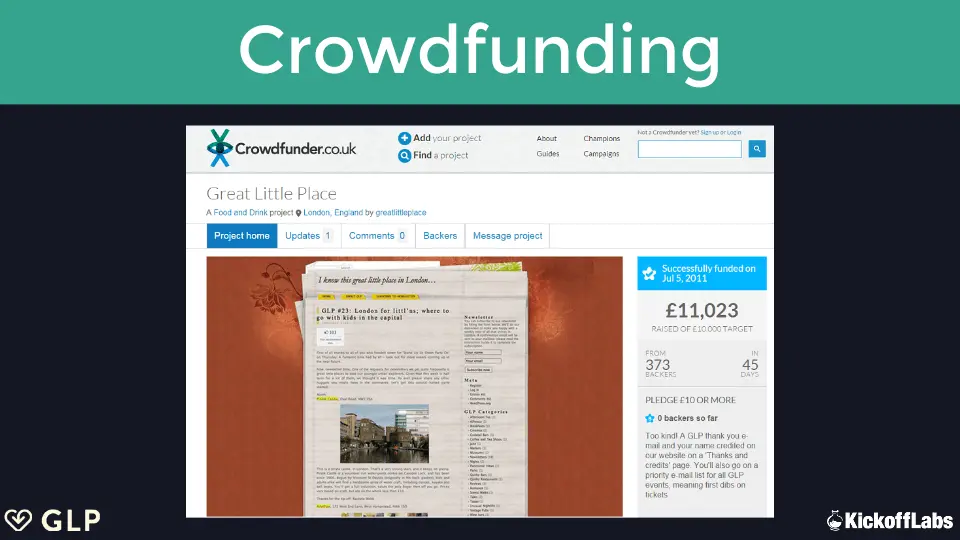

Josh Ledgard, Co-Founder of KickoffLabs:
You mentioned raising £10,000 pounds from your audience through crowdfunding… and at this point you had 100,000 or 200,000 followers on social media.
Did you just ask fans to check out the crowdfunding page and back the project?

Rossa Shanks, Co-Founder of Great Little Place:
The trick with crowdfunding is, it’s definitely not easy.
We weren’t raising lots of money, but we were essentially asking for free money, because our prizes were pretty weak.
The top prize was if you put in £500 pounds sterling, we’ll sort you out a trip to a great little place somewhere. Because we’ve got relationships with the venues and we can get free stuff.
The basic prizes were stuff like, put in £10 and you’ll get on our credits’ page. Put in £50 and you’ll be invited to our launch party, that sort of stuff.
We didn’t have a product, we weren’t selling some new tech product that we could give away a discounted value on.
It was very much asking for support just for the sake of the idea. You can see all the names here of all the people that supported us. There was over 300 people I think that chipped in, just small amounts, but some people put in quite a lot. One person put in £500 and we just literally didn’t know who they were.
With crowdfunding you’ve got to be prepared. You need your own network, to a certain degree, and you need to ask the network before you do it, “Would you be willing to pledge money?”.
Get pre-pledges and get people warmed up to the idea before actually launching your campaign.
I would also give yourself as much time as possible. I would do the maximum, not the minimum. We actually did it in quite a short period of time; I think it was 45 days. But it got a bit hectic near the end when we thought we might not make it. You’ve got to give yourself enough time.
Good prizes are obviously always good. If you’ve got a product that you can actually offer a discounted price on, that’s a good place to start.
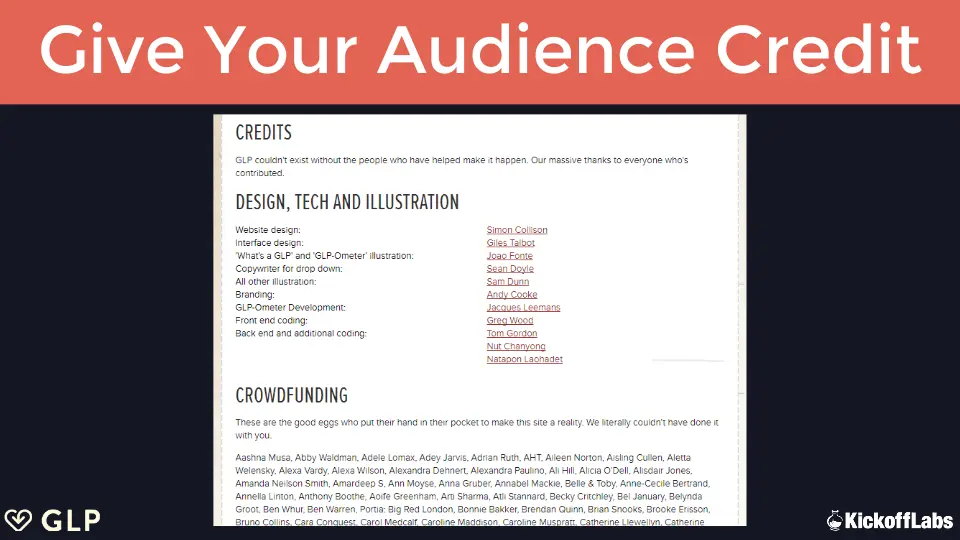

Josh Ledgard, Co-Founder of KickoffLabs:
I love the idea. It’s something that a lot of people forget to do, is just saying thank you.
That page that’s up there is just a great way to say thank you to the audience; people who are helping, who are funding at that point, who are maybe contributing pieces of what you were doing.
Let’s talk about the app and the landing page.
You said you always wanted to get into mobile and already had a decent sized audience, but told me in private that your goal is to collect 100,000 email addresses through the mobile app pre-launch campaign.
Why collect 100,000 email addresses as part of this app launch?

Rossa Shanks, Co-Founder of Great Little Place:
The answer is simple: The anticipation of something can really contribute to the excitement of it.
If we’d have just released our app into the wild, yes, I guess people would have responded well. But it’s much easier to sell the promise of something before you launch it.
With something like an app, there’s various things you need to consider…if we can build up an audience before we launch – so that on day 1 when we launch there’s a ton of people downloading the app – that helps you from a distribution point of view because you’ve moved up the ranks in the app stores.
To get to number 1 in any category on a single day, you probably need, in the UK anyway… it’s probably more in the states… about 15,000 downloads. In the states I imagine it’s probably 50 to 100,000.
Those things help get organic growth from users. We want to launch with a big bang with that organic wave.
Also, when something’s not launched early adopters get excited. And when you’re trying to sign people up, the promise of something’s more exciting than the reality often. Obviously we’re going to make ours as good as it can be, but that’s the psychological truth about it.
People want to feel like they’re cutting edge and they’re going to be the first to trial something, and that’s exciting, and be the first in the know… and they want something they can’t have.
You can capitalize on a lot of psychological hooks there, that are just part of our human makeup.
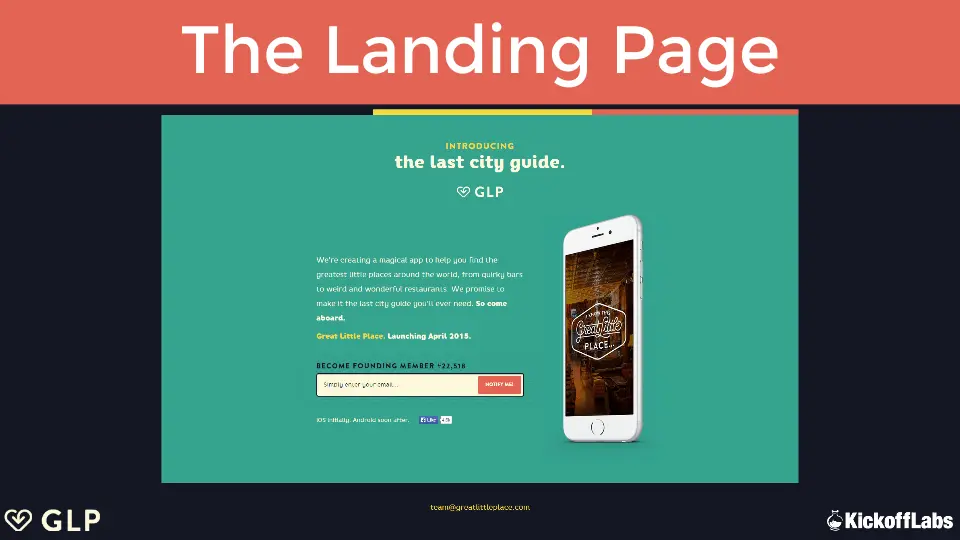

Josh Ledgard, Co-Founder of KickoffLabs:
I want to talk about a couple of the psychological hooks that you’re leveraging on your KickoffLabs landing page.
One of the things I notice right away is that you’ve text above the email box that says “Become Founding Member #…”.
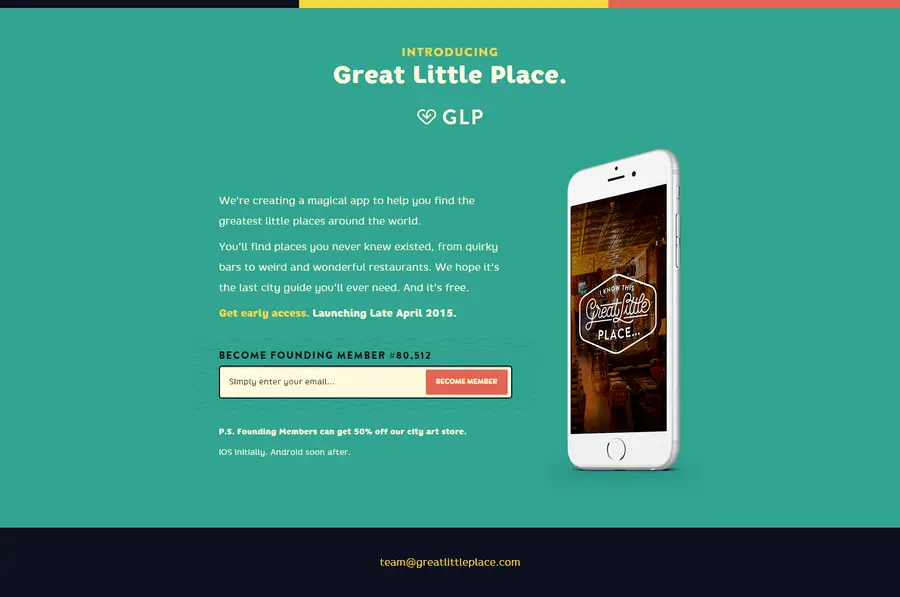
What do you think, is the impact of that number right above the email list?

Rossa Shanks, Co-Founder of Great Little Place:
We spent a lot of time reading books on virality, on social behavior, how you engender viral effects, and how you make something contagious.
Everything on the page is deliberate for us. It wasn’t that we just mocked something up, just got it out there… every single thing is considered.
We’ve made changes to that page every week since it launched. KickoffLabs gave us some useful feedback and we’ve made even more changes.
The “Founding Member” thing… is utilizing the concept known as social proof. All that means is we very much follow a herd behavior a lot of the time.
If you pass 2 restaurants; and on one side a restaurant is full, and on the other side of the street a restaurant’s completely empty… we’re kind of risk-averse as human beings. We assume that the one that’s full, is full because of merit; because it’s got better food or whatever the case may be. It might be that actually the other restaurant is exceptionally good, it’s just no one was brave enough to be the first person to walk in there.
Social proof’s really important. You’re much more likely to go to the restaurant that’s full than the one that’s empty.
The same principle applies here: if you can see that a lot of people have signed up to something and it’s popular…
- it gives it endorsement,
- it means that you’re not wrong for thinking that this is a good idea to sign up,
- it helps engender a fear of missing out.
You want to be part of that community, you want to be part of the “in crowd”.
That’s why on a later iteration of this page we use language like, “Get Early Access” because that taps into people’s adoption process. “Become Founding Member” to make it feel like a club and make them feel important.
TIP: The Great Little Place team were in fact manually updating their founding member number “by hand”. Granted they were updating this with their true audience size… but you can potentially use this growth hack for your campaigns, just but careful not to artificially inflate # this too much!
We very much display the total figure because that’s really important. Once you get to a certain amount it’s almost the tipping point and it helps with your conversions when new people land on the page.
We also deliberately made the page sparse of lots of different social buttons and we’ve also got different versions for different cities. This page you’re displaying here is a generic one, but for our London iteration we’ve got a lot of fans in London; we’ve got 320,000 fans now. That was also another bit of social proof.

For us the purpose of the page isn’t to get more likes, or to get more followers; we removed all those buttons, so there was no other real distraction apart from just putting in your email.

Josh Ledgard, Co-Founder of KickoffLabs:
I love that, because that’s the opposite of what I see a lot of people do.
A lot of people come to us and they say, “I want to add my Pinterest, Instagram, Twitter… all of these things… and I want this parallax scrolling effect on the page”.
You guys boiled it down to the simplest thing you could get that gets people to convert.
The other thing about this page which struck me is; there’s no slideshows, there’s no scrolling effect, there’s not 100 bits of feature information on the page about what it is.
It talks about their mission. It says, “Introducing the last city guide. We’re creating a magical app to help you find the greatest little places around the world, from quirky bars to weird, wonderful restaurants. We promise to make it the last city guide you’ll ever need, so come on board“.
Notice it doesn’t talk about features of the app, what it’ll do, how specifically it helps you. It talks about why they exist.
That’s probably the most challenging copy for people to write… thinking about the why on the page, like why you should become a member.
Some people don’t get to the point where they talk about what the app is, but if you spend too much time focusing on sharing the what of a coming soon application, then you’ll lose track of the why.
The why is what’s really effective on this page at getting people to convert, because they’re presenting their mission, and they’re looking for people who really want to be part of that mission, of why Great Little Place exists.

Rossa Shanks, Co-Founder of Great Little Place:
Were you talking about Simon Sinek’s Start With Why, is that right?

Josh Ledgard, Co-Founder of KickoffLabs:
Yes, in a roundabout way. I was explaining how on your landing page you hardly mention anything about the app, other than showing that it is an app on a phone. You’re talking about the why.

Rossa Shanks, Co-Founder of Great Little Place:
100%. We talk about that a lot.
But whenever I hear startups pitching their ideas, they always start with what it is. Doing that you’ll lose people. You’ve got to make it relevant to them.

Josh Ledgard, Co-Founder of KickoffLabs:
Do you have any book recommendations?

Rossa Shanks, Co-Founder of Great Little Place:
Start With Why is a great book. If you don’t fancy reading the whole thing he’s got a Ted Talk that sums it up in 5 minutes.
Contagious by Jonah Berger is a very good book. It runs through all the different ways in which you can make an idea spread, like making something very visible so other people can talk about it.
I know it’s gone badly since… but the Lance Armstrong yellow LiveStrong band was contagious because so many people saw it when it was a talking point.
I think Contagious is relevant to whatever business; it’s not just about tech startups, it’s just the principles of how to spread an idea.
Viral Loop by Adam Penenberg as well, which is a good book. I think I probably prefer Contagious, but it’s definitely a good book.
Andrew Chen did another more like a blog into a book, which is pretty good, called The Viral Startup.

Josh Ledgard, Co-Founder of KickoffLabs:
I’m grateful you guys are happy to share some of the numbers here with us.
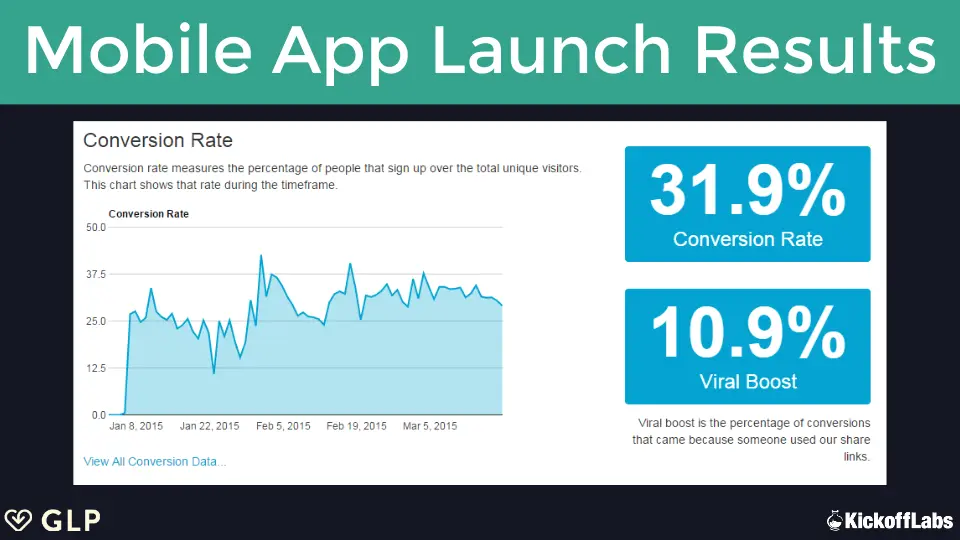
This is straight off of your dashboard, and it shows from January, your conversion rate through recently.
What kind of expectations did you have going into this? Were you hoping for a 10, 20, 40% conversion rate?
What kind of expectations or goals did you set?

Rossa Shanks, Co-Founder of Great Little Place:
It’s really hard with these things, because I think there’s an expectation as an entrepreneur that when you finally get someone on your platform they will do whatever you want them to do… and of course they’ll be dying to sign up for this amazing thing that you’ve created.
But of course, no one ever gets 100% conversion. It just doesn’t happen, because someone could go on a page and get distracted at work and then forgets about what they were doing, and then goes off. It’s impossible to get everyone.
We knew it was going to be under 50%, because obviously 50% would be ridiculously high. We also realized not everyone is on iPhones. There’s a lot of Android users and there’s Windows users as well, etc.
Unfortunately for us, we were only able to develop for the iPhone first, and we will move to Android and other platforms later… so you’re naturally going to get a drop off there. Then, not everyone gets excited about the idea.
When we first started, the conversion rates were like 27%, around about that, and my goal was to get that up to over 30%.
I’m happy to say it’s just under 32% over the whole period.
I think that has come from making those little tweaks on the page from different people’s opinions. KickoffLabs gave us some great advice and we made some fundamental changes which instantly saw results; where last week’s conversion rate was more like 34%, which has dragged up the whole average to 31.9%.
The trick there is, whenever your page is live, never think it’s done. It can always be improved.
We haven’t done this and should have done, but A/B testing different things. Even like the copy on a button. We started off with “Notify Me”, and we’ve changed it to “Become Member”, just because it feels more exclusive. That was a suggestion from KickoffLabs that we implemented.

Josh Ledgard, Co-Founder of KickoffLabs:
What did you use to build the landing page?

Rossa Shanks, Co-Founder of Great Little Place:
We got a web developer to do it. It’s just simple HTML and CSS, there’s nothing fancy there.
It’s a pretty simple page and it’s responsive as well. I think that’s really important, especially for us. We’re a mobile app, and all the advertising we’ve done to that page is to mobile devices.
Don’t think for a second that it’s done when you’re looking at a desktop version. Check it on your phone, because over 50% of people will check the page from their mobile device, without a doubt. That’s really important, that it’s responsive.

Josh Ledgard, Co-Founder of KickoffLabs:
You then used our Anyform widget to plug in your custom built landing page to KickoffLabs?
Which is great; that’s why we developed it :)
We knew that everybody has a unique vision, and we could have 1000 templates in a marketplace, but people would still want to do something on their own to implement it.

Going into the next set of numbers, if you look at over time the leads generated, there’s 3 distinct spikes in here with the leads that come in.
Can you talk about what happened in these dates, January, February, and then later in March?

Rossa Shanks, Co-Founder of Great Little Place:
That first initial spike, mid-January was purely our organic social media. We posted to 3 of our Facebook city pages, all of them in the UK – London, Glasgow, and Edinburgh – and that’s why we saw good organic numbers then.
We were tweeting about it, although Twitter doesn’t tend to drive up huge traffic.
You can see that organic curve goes down as people get bored of being pestered to sign up on your page.
Then you’ll start to see there was a mini-spike in February, twice there. We started experimenting with using advertising to drive to the page. We’re assuming the actual cost of signing up someone for the app launch is going to be a lot cheaper than once we’ve launched.
It’s a whole other ball game when something is already out there and you feel like you’re being advertised to because you’re saying “download me now”, and it feels a like a hard sell.
When you’re promoting something before it’s actually launched it can be much more engaging a lot of the time.
Advertising worked okay, and this is all on Facebook. We did actually try Twitter Ads as well, but we found Twitter wasn’t as effective for us.
Then we put very low effort into the promotion mid-February onwards, because we’d been really super-busy actually making the app and getting it ready.
What’s happened in the third spike is, we feel like we’ve really cracked a formula that works on Facebook for the ads. We’re using a new format that Facebook’s rolled out called Multi-Product Ads, that’s working really well for us.
These seem to be better ads, there’s not even call to actions on them so then don’t really feel like ads.
One of them just says it comes from our page I Know This Great Little Place in London, and it says, “London has many secrets, We have the key.” Then a range of images of just amazing places, whether it’s a cocktail bar or a romantic restaurant.
The hilarious thing is, people have been tagging themselves in the ads, going, “hey, we must go here … Sara, take me here! … things like that, and tons of likes.
Again, that social proof kicks in, because as soon as an advert starts getting comments and likes and shares, other people think, “Oh, this is okay, this thing must be good. Maybe I’m missing out here, I’ll get involved“.
They’ve been incredibly effective for us over the last week, and I think we’ve driven, just in one week alone 30,000 sign-ups!
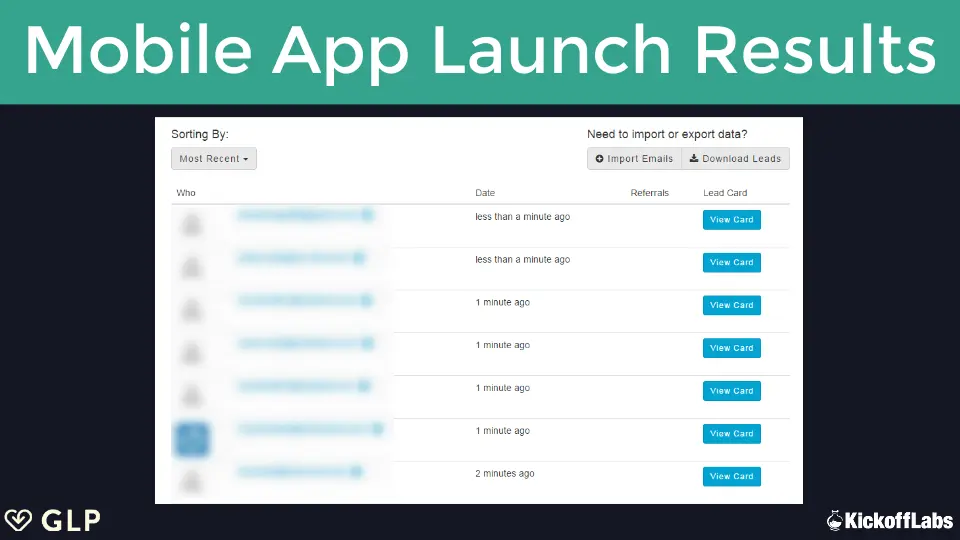

Josh Ledgard, Co-Founder of KickoffLabs:
That’s pretty amazing to get 30,000 just in the one last week.
It sounds like one of your techniques in the ads is you’re making something that feels like it’s at home in the Facebook feed. It’s not something that’s like, “Hey, come sign up for me“.
You’re making something that tries to pique somebody’s interest in the feed. Is that correct?

Rossa Shanks, Co-Founder of Great Little Place:
Yeah, that’s right. I think it almost feels like it’s not an ad.
We’ve deliberately not used any of Facebook’s traditional buttons that you can add. Facebook has buttons like “Shop Now”, “Download”, “Sign Up”. We deliberately decided not to use them, because we thought it would be more natural if we did a soft sell.
In the text of the ad we’re not saying, “Download our app now … sign up now“. We’re just creating intrigue.
The copy is stuff like, “London has many secrets, we have the key”. We’re being quite enigmatic.
Other ones are a bit more overt: One is, “Our app is going to be your ultimate little black book of places“. Another one is, “Find places you never knew existed“. All of the ads contain a range of beautiful imagery.
The best thing on Facebook is to fit in with the community, don’t oversell.
Use amazing imagery, because it’s a visual platform.
The tone of voice is important as well. For us, a good tone of voice is making something feel cool and making everyone feel like they’re an insider if they get on board.
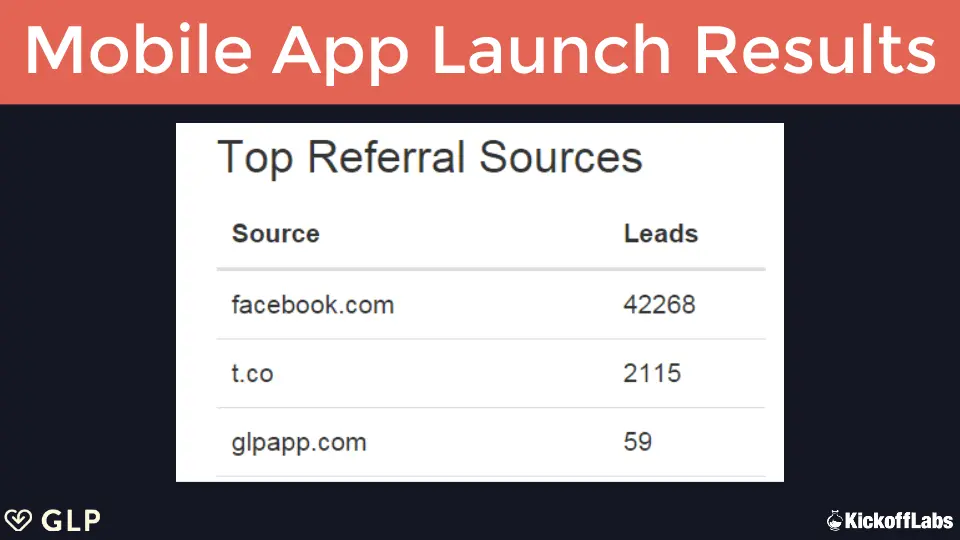

Josh Ledgard, Co-Founder of KickoffLabs:
It’s certainly showing that’s where your leads are coming from.
Looking at your stats, of the 50,000 people you’re dealing with, more than 80% of them are coming from Facebook, so it certainly is a working strategy for you.
How are you sourcing the photos? Both for Facebook and for the mobile app?

Rossa Shanks, Co-Founder of Great Little Place:
For posting on Facebook, a lot of venues have their own photography so we just ask them.
We also know quite a few photographers who take amazing pictures of London and other places around the world. They love what we’re doing and said we can use their photography as long as we credit them. That’s what we do there.
The way the mobile app will work going forward is it’s all people’s recommendations. The initial concept is recommendations we’ve taken from our Facebook pages around the world, so when you come to the app it’s useful, there’s content there for everyone to see.
But very much the engine of growth for that concept is people adding their own. What happens is we have a system for that whereby when someone adds something we have a team of people that contact the venues or work with them, and get images from their websites and that sort of stuff, so the app is full of beautiful imagery.
One thing we realized very early on was a picture really does tell a thousand stories.
If you’ve got a great image of a venue, an image tells you as much as a long review, if not more… and whether it’s going to be something you’ll like or enjoy or you think looks cool.
Images are really paramount for us.
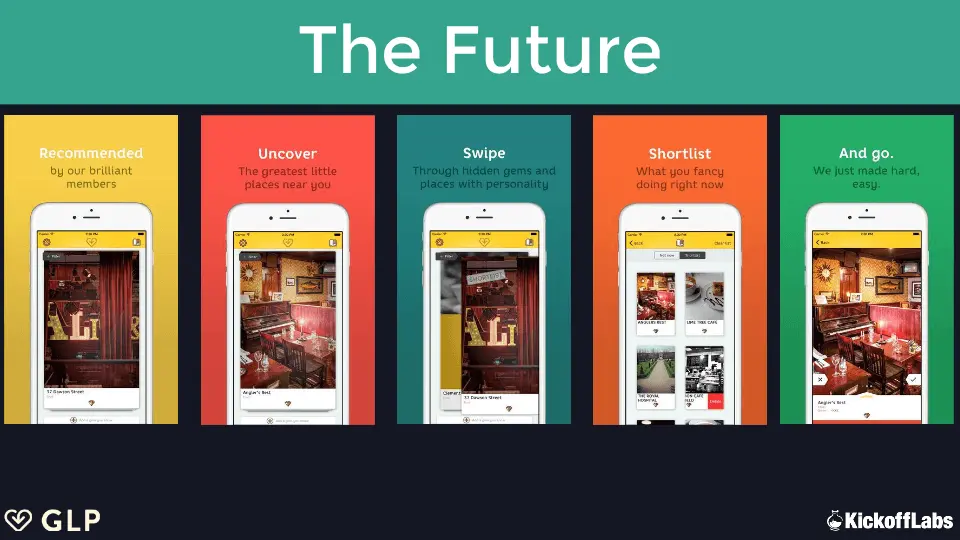

Josh Ledgard, Co-Founder of KickoffLabs:
Let’s talk about the future. You specifically quit your job about 15 months ago…
Are you feeling confident about the growth and the business model?

Rossa Shanks, Co-Founder of Great Little Place:
Yes. I think we’ve cracked a great product.
It actually looks a lot different to the one you’ve got there; we’ve improved the design immensely.
I think the great thing is,if you’re in a tech startup, the cost of producing products now has diminished incredibly.
It’s not free to make a digital product, but it’s a lot cheaper than it used to be. There’s a lot of platforms that help you develop and all those sort of things. There’s lots of code that’s already been written that you can reuse and things like that.
The trick really, with all these things that define success, is actually the marketing of them.
Can you get traction for it?
Everyone can build a product, but not everyone can find a market for that product.
That’s really encouraging for us, that people have rallied around the idea on social media. We get tons of lovely emails from people randomly just saying, “love what you guys are doing, wish you all the best”. Those sort of things make us think we’re on to something.
What’s really been great is these signups on our KickoffLabs landing page. If that gets to 100,000 before we launch, or more if we dream a little bigger, then I think we’re going to off to a really great start.
When I look at other big companies that have gone on to be hugely successful, most of them didn’t even start with the numbers that we’re starting with pre-launch!
That’s given us a lot of confidence in what we’re doing, but it always remains to be seen.
I think we’ll be okay from a user acquisition point of view. The question is, as always in the mobile app world, is whether people stick around and whether you can retain them. A lot of apps get downloaded, used once, and then no one ever comes back.

Josh Ledgard, Co-Founder of KickoffLabs:
Aside from crowdfunding, have you guys taken any other sources of funding?

Rossa Shanks, Co-Founder of Great Little Place:
Yeah, we raised an angel round last July, and then a seed round. What we’re aiming to do this year if we hit the numbers that we want to hit, is we want to raise a Series A round, which will be significant.

Josh Ledgard, Co-Founder of KickoffLabs:
How many people are working with you guys now?

Rossa Shanks, Co-Founder of Great Little Place:
We’ve got in the office a team of 4, we’re hiring 3 more as we speak… we’re hiring 3 developers at the moment. So there will be 7 very shortly.
If we take on a Series A, that team will probably grow to 20 or so. We’ll probably open an office in the US, I imagine.

Josh Ledgard, Co-Founder of KickoffLabs:
That’s amazing! It’s great to hear that kind of success.
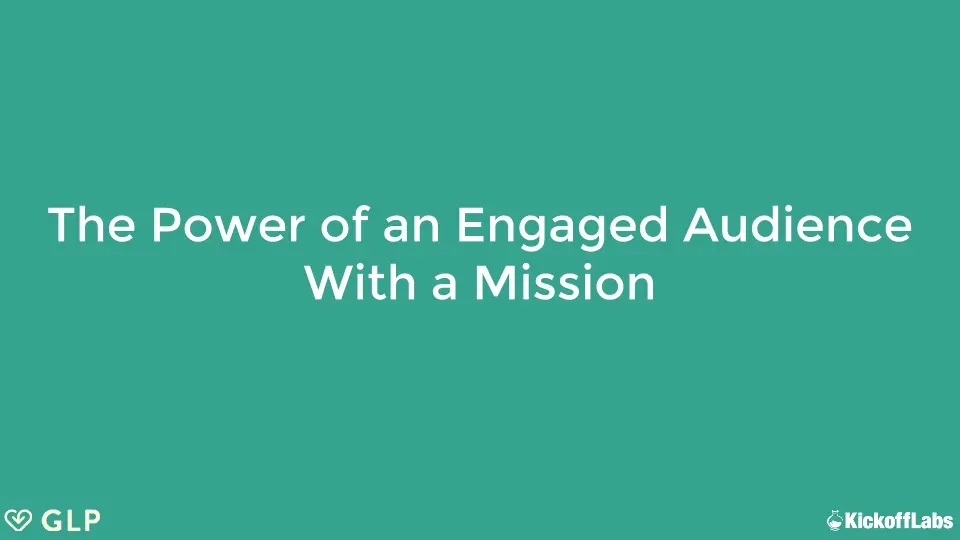
I think what’s interesting is that you guys are really harvesting the power of an engaged audience with a mission.
You have a really clearly defined why, you’re giving people a mission to find these places, and you’re getting them engaged in your story… and helping them.
It’s what people want. A problem they want to have solved. It’s amazing to me to see how powerful that can be in action.
We had somebody in the chat who said they liked one of the Great Little Place Facebook pages ages ago, hadn’t used the platform or the app yet, but thought their feed on Facebook was the best platform for them to discover things.
What I took away from that is that you’ve got this multi-layer audience where you’ve got:
-
people that may just engage with you and follow you on Facebook,
- people that are going actively to the website,
- an audience that’s going to be participating in the app and seeding all the content and participating through the app at the highly engaged side of things.
You guys have done an excellent job in providing content for each of those different levels…
It seems like all that’s intentional. Am I right?

Rossa Shanks, Co-Founder of Great Little Place:
Yeah it is. Community’s everything for us.
The idea is about getting everyone’s recommendations. You’ve really got to look after the community, and that isn’t easy, but it does mean you’ve got to respond to every email that comes in.
Those people – every person you touch – they’re probably going to tell 20 people about you, if they love what you’re doing.
It’s sometimes a deluge of information and connections that you get when you’re on multiple social platforms; Pinterest, Twitter, whatever you might be on. It can be a handful, but it does pay dividends if you do everything right by the community. You keep them involved.
One example is, we have a private group of about 500 people, a private community for GLP that we’ve cultivated to keep them involved with the app development, to get their advice and feedback.
Whether it’s saying, “do you like these designs? do you like the color?“, we got them involved with our rebrand.
We have 400 people voting in a Survey Monkey about which colors and which brand and icon they liked and preferred.
People really respect that openness and engagement.
The trick with social media is just to be yourself and open, and keep people involved. Don’t think of yourself as a company. Everyone knows there’s a person writing those things. You’ve got to be normal and natural.

Josh Ledgard, Co-Founder of KickoffLabs:
Is there anything that you would have expected a question about or something we didn’t talk about that you feel like the audience missed out on?

Rossa Shanks, Co-Founder of Great Little Place:
One thing I’d like to elaborate on is; I sort of feel like we’ve been lucky enough to have the traction in social media and other things.
But in other ways, of all the services and products – our one in particular, which is about going out, and your social life – fits in particularly well with especially Facebook where it’s more personal connections, etc.
The thing is, it might seem like there’s not a lot to learn from that, because if you’ve got something other people might consider dry, like a financial services company or something, or you’ve got an expenses app that you’ve developed… to a lot of people that might seem a bit boring, and it might feel hard to figure out how you might engage people in social media if you’ve got something that on the surface might appear a bit boring.
But the trick with social media is to either make something entertaining, or make it useful. A lot of products can still provide a lot of utility.
Back to the mission point in the Simon Sinek thing; if you start with why… if I was developing, let’s say, an expenses app.
If I was developing an app called “Finance App”, and another one called… let’s call it the “Reassurance App”.
The “Finance App” might describe their product like this: “We help you log all your expenses and your finances so it’s all in one place and really convenient”.
Whereas the “Reassurance App” might be more like: “We understand how stressful it is when finances get out of control, and we think everyone should be financially literate. Because if you are then you’ll be stress-free and lead a better life and be able to invest in things you want to. We just happen to make an expenses app that’s really simple to use”.
That’s an example of thinking about what your why is, and if you were to take that through to social media, you’ve got your social strategy right there: Helping people become financially literate, and giving them advice, tips, things like that.
What I want to communicate is you can find a mission in almost anything. Even if it feels like you’ve got a product that people might not naturally get behind.
If you can tap into a human truth or a human behavior or something, you can leverage that and still build a community that’s engaged.

Josh Ledgard, Co-Founder of KickoffLabs:
That makes total sense, and it’s a great thing to bring up and remind people of.
When launching or growing your business…
What was something that you were wrong about, or thought was correct but turned out to be false?

Rossa Shanks, Co-Founder of Great Little Place:
That’s a very good question. We’re definitely not always right!
I think if anything, we probably should have gone to mobile quicker.
We probably spent too long with our website, when it was clear to us that if you looked at the stats most of our traffic was mobile. Alarm bells really should have been ringing in our ears to say it’s time to develop the other platform, instead of continuing on.
Business is not necessarily about making wrong decisions, as every decision has its permutations.
I don’t think we’ve made anything catastrophically wrong, but what I would say is we could probably have made decisions a lot quicker.
If we’d have focused on what our audience really wanted, which we’d had emails obviously saying, “you guys should do a mobile app”, and obviously we wanted to. But we probably delayed it much longer than we should have done.
We should have started it a long time ago. Lesson learned.
I don’t think we’ve lost out dramatically, I think in some ways we’re probably building a better mobile product today, than we would have done had we built it 2 years ago.
The mobile space has evolved, and there’s a lot more exciting things you can build upon and do.

Josh Ledgard, Co-Founder of KickoffLabs:
There’s something to be said for the fact that you guys spent a lot of time building the audience first ahead of building the app.
You let other people get some of the trial and error out of the way.
You’ve taken on a little bit of funding, but for every business, no matter how they take on funding, cost is still extremely important to consider. If you guys went out and blew a bunch of money on being an early adopter of mobile platforms, you wouldn’t be able to take on the advice of seeing all the apps that have tried and failed or tried and done well.
Now you can leverage a lot of that success into your audience that you’ve spent your time building. Which is not necessarily wrong because you spent time doing other valuable things for the business, which was probably a great thing to do.

Rossa Shanks, Co-Founder of Great Little Place:
I think that’s right. A lot of the apps out there, when you load them up, whether it’s Foursquare or Yelp or all these things, they just show you lists of places, and it’s literally like a tiny thumbnail of the venue, the name of it, how far away it is, and the rating… and it’s not particularly inspirational, and it doesn’t pique your interest.
That’s why we’ve gone a very visual route and we show you one place at a time. We’ve got fewer places, so we want you to consider them all, and show them off in all their glory.
Seeing what other people have done in the market has helped us to then differentiate ourselves. Because we haven’t honestly raised as much money as Yelp’s done, and they’re a massive player, so we’ve got to be different and we’ve got to innovate in a different way.

Josh Ledgard, Co-Founder of KickoffLabs:
This was a lot of fun. I’ve learned a lot from your story.
One of our chat attendees said “This guy has got it nailed”… whenever we get comments like that during our chat, we can tell there’s a ton of good advice that people are going to enjoy.
Definitely go check out the Great Little Place mobile app signup page, if you’re interested in finding great little places all around the world. Go to glpapp.com
As a final question…
How would you define KickoffLabs’ why and what we’re helping you do?

Rossa Shanks, Co-Founder of Great Little Place:
I would say:
“We understand how important it is to get your business off to the right start. We think the best way to do that is to build up an engaged audience that are raving about your product.
That’s why we built a product that has viral loops in-built to really get people signed up even before it launches”.

Josh Ledgard, Co-Founder of KickoffLabs:
Appreciate the feedback. It’s good to hear from a customer what message they take away. There’s elements of that we talk about behind the scenes that we could do a better job of explaining to our other customers :)
Now go check out kickofflabs.wpengine.com if you haven’t already…
We make it easy for you to get off to the right start, build an engaged audience from the beginning. We’ve got a lot of great tools to help you get there.
